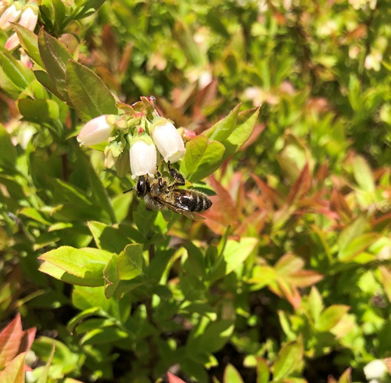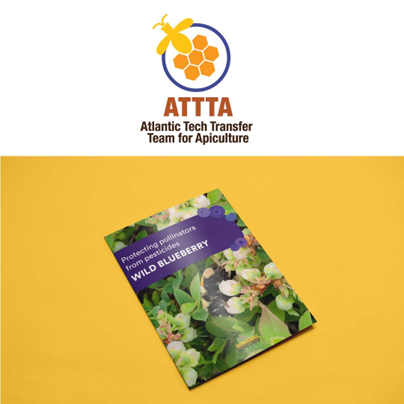Pollination is here and with that, both beekeepers and blueberry growers need to consider how they can best protect honey bees, and other pollinators from the numerous pesticides used on wild blueberry fields. Recently, ATTTA and Pollinator Partnership Canada have published a best management practice guide “Protecting Pollinators from Pesticides – Wild Blueberry”1. We encourage you to read and engage with this guide found at https://www.perennia.ca/portfolio-items/honey-bees/. In this week’s blog we will cover the highlights of the various practices to protect pollinators from pesticides, but for a more in-depth understanding please read the guide in its entirety.
Practices to Protect Pollinators from Pesticides
The first
approach for beekeepers and blueberry growers to protect
pollinators, is the use of integrated pest management. The
use of integrated pest management can help minimize the amount of pesticide use on wild blueberry fields2. The grower should monitor for
the presence of various fungus, insect, and plant pests of wild blueberries,
and only provide treatment when needed2. By minimizing the amount of
product being used this lowers the risk of pollinators being exposed to harmful
chemicals. An IPM approach has the added value of also saving the farmer time
and money on product application2.
Probably the most important component for protecting pollinators from pesticides is clear communication between growers and beekeepers. Both beekeepers and growers will benefit from having clear guidelines for each of their roles in the pollination process. If receiving or providing pollination services, it is recommended that a pollination contract is used. Examples of pollination contracts can be found within "Best Management Practices Guide for Honey Bee Pollination of Wild Blueberries in Atlantic Canada”3 at https://www.perennia.ca/portfolio-items/honey-bees/. Modify any template contracts as needed, but it is encouraged to include information on: the timing of arrival/departure of hives (needs to be in sync with wild blueberry bloom); responsibility of beekeeper to provide standard pollinating units; details of grower's responsibility to protect bees from any pesticide poisoning; designation of responsibility for periodically checking and caring for bees; designation of responsibility for providing hive protection (electric fencing); clear description of the pest management practices being used on the blueberry field before and during placement of hives; and details of hive placement location on the field.
Beekeepers
and blueberry growers can both work to support pollinators through habitat
development. Maintaining and creating habitat around blueberry fields can
support honey bees and native pollinators4. Leaving non-invasive
weeds, wildflowers, and other habitat patches around wild blueberries increases
pollination and fruit production5. The presence of these native wild
flowers will provide a diversity of pollen sources and will not deter honey
bees and other pollinating insects from foraging for nectar on wild blueberry
plants6. There are several things growers can do to help develop
these habitats, such as delay flail or bush mowing areas around fields until
after pollination and preserve wildflower diversity currently surrounding
fields. On fields that border cultivated land, growers can create floral strips.
The use of
pesticides is an integral part of wild blueberry production. There are several
practices beekeepers and blueberry growers can follow to help minimize the
impact of these products on pollinators. The first thing growers can do is
select the least toxic pesticide to bees. Bees foraging on fields can be
directly exposed to toxic products or exposed indirectly through ingesting
pollen and nectar containing the product or contact with contaminated soil7.
Generally, insecticides are more toxic to bees than herbicides or fungicides
since insecticides are formulated to kill insects. The risk associated with a
particular pesticide to bees is not only based on the toxicity, but also the
residual toxicity. If a product is found to be toxic for greater than 8 hours
than it is a higher risk to bees. For questions regarding a specific product’s
risk to bees refer to the “Supplement Document for Protecting Pollinators from
Pesticides” at https://www.perennia.ca/portfolio-items/honey-bees/.
Whenever
applying a pesticide is essential to follow all label directions. When
reviewing the label look for precautionary and advisory statements that state
“toxic to bees”.
Finally,
growers and beekeepers need to minimize any potential exposure of bees to
pesticides. Growers should avoid applying pesticides when bees are flying or
clustered outside their hives; avoid applying pesticides to any blooming
flowers around the field; place hives outside the range of pesticide
application and consider developing a no spray buffer zone to protect hives;
minimize pesticide drift when spraying; and look for nests of native bees
around the field to avoid spraying near the area.
Protecting
honey bees and other pollinators from pesticides is crucial for successful
pollination. It is in the beekeeper’s and grower’s best interest to have
conversations around pesticide use, and how they can work together to protect
these vital insects.
- Orr, J., Byers, A., Morandin, L.A., Medeiros, S.J. and K. Law. 2023. Practices to Protect Pollinators from Pesticides: Wild Blueberry. Pollinator Partnership Canda and Atlantic Tech Transfer Team for Apiculture.
- Brodt, S., Zalom, F., Krebill-Prather, R., Bentley, W., Pickel, C., Connell, J., Wilhoit, L. and Gibbs, M., 2005. Almond growers rely on pest control advisers for integrated pest management. California agriculture, 59(4).
- Bennett, A. and A. Byers. 2023. Best Management Practices Guide for Honey Bee Pollination of Wild Blueberries in Atlantic Canada. Atlantic Tech Transfer Team for Apiculture.
- Park, M.G., Blitzer, E.J., Gibbs, J., Losey, J.E. and Danforth, B.N., 2015. Negative effects of pesticides on wild bee communities can be buffered by landscape context. Proceedings of the Royal Society B: Biological Sciences, 282(1809), p.20150299.
- Blaauw, B.R. and Isaacs, R., 2014. Flower plantings increase
wild bee abundance and the pollination services provided to a pollination‐dependent crop. Journal of Applied Ecology, 51(4),
pp.890-898.
- Girard, M., Chagnon, M. and Fournier, V., 2012. Pollen diversity collected by honey bees in the vicinity of Vaccinium spp. crops and its importance for colony development. Botany, 90(7), pp.545-555.
- Willis Chan, D.S., Prosser, R.S., Rodríguez-Gil, J.L. and Raine, N.E., 2019. Assessment of risk to hoary squash bees (Peponapis pruinosa) and other ground-nesting bees from systemic insecticides in agricultural soil. Scientific Reports, 9(1), p.11870.
Connecting with ATTTA Specialists
If you’d like to connect with ATTTA specialists or learn more about our program, you can:
visit our website at https://www.perennia.ca/portfolio-items/honey-bees/
Email abyers@perennia.ca


